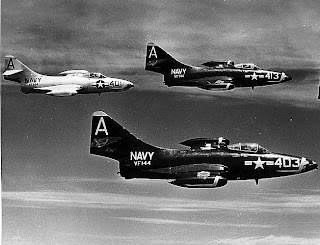By 1950, the Navy had determined that overall dark sea blue was too visible under certain conditions for some missions, so it was inclined to adopt a paint scheme that was less so. One under consideration was the Air Force practice of leaving the aircraft unpainted, except for markings and skin panels that were not as corrosion-resistant as those formed from Alclad aluminum. Not painting aircraft had the additional benefit of reducing weight as well as initial and operating cost. Ever cautious, however, and in consideration of the much more corrosive environment that its carrier-based aircraft were subjected to, the Navy embarked on an evaluation program. Beginning in April 1952, the experiment was to involve approximately 100 F9F-5s (including F9F-5Ps and at least one F9F-2), all F7U-3s, 100 F2H-3s (and apparently some F2H-4s) and all FJ-2s. In cases where the external skins were not Alclad, they were painted with an aluminized lacquer that closely resembled the natural metal.
The natural metal F9F-5s and F2Hs were scattered among squadrons that also operated over-all blue airplanes.
The light gray areas on the F7U's aft canopy, lower side of the nose, and rudders are magnesium or other material which required painting for corrosion protection or to match the overall natural metal finish.
Some strangely colored F9F-5s resulted from aft fuselage substitutions to maximize the number of airplanes available for missions.

Although there are reports that a clear coating was used to protect the bare aluminum, it would appear from at least one report that the only protection suggested was a wax that was not readily available. By mid 1953, the results were already becoming apparent: corrosion ranging from slight to severe. Any cost benefit of not painting the aircraft was more than offset by the additional corrosion control effort required. One deployed squadron reported corrosion spots that varied up to 1/8" in diameter and several thousandths of an inch deep. In February 1955, the Navy decided to paint all its tactical airplanes in a gray/white scheme with the experimental airplanes to be painted by July 1955.
For more background on this experiment, see this 1953 issue of Naval Aviation News, pages 13-15.










